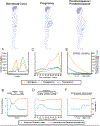Gut and vaginal microbiomes on steroids: implications for women's health
- PMID: 34049772
- PMCID: PMC8282721
- DOI: 10.1016/j.tem.2021.04.014
Gut and vaginal microbiomes on steroids: implications for women's health
Abstract
This review discusses the interactions of steroids with the gut and vaginal microbiomes within each life phase of adult women and the implications for women's health. Each phase of a woman's life is characterized by distinct hormonal states which drive overall physiology of both host and commensal microbes. These host-microbiome interactions underlie disease pathology in disorders that affect women across their lifetime, including bacterial vaginosis, gestational diabetes, polycystic ovary syndrome (PCOS), anxiety, depression, and obesity. Although many associations between host health and microbiome composition are well defined, the mechanistic role of the microbiome in women's health outcomes is largely unknown. This review addresses potential mechanisms by which the microbiota influences women's health and highlights gaps in current knowledge.
Keywords: estrogens; gut microbiome; menopause; polycystic ovary syndrome; pregnancy; progestins.
Copyright © 2021 Elsevier Ltd. All rights reserved.
Conflict of interest statement
Declaration of interests The Mayo Foundation for Medical Education and Research (inventor M.R.S.W-A.) has been issued a patent 'Methods and Materials for Treating Endometrial Cancer', US10072303B2. The content of the patent relates to the use of the microbiome to address endometrial cancer. M.R.S.W-A. is a member of the scientific advisory board of LUCA Biologics Inc. on research related to urinary tract infections, preterm birth, and reproductive medicine. The other authors declare no conflicts of interest.
Figures


References
Publication types
MeSH terms
Substances
Grants and funding
LinkOut - more resources
Full Text Sources
Other Literature Sources
Medical

